
A 2-8-8-4 steam locomotive, under the Whyte notation, has two leading wheels, two sets of eight driving wheels, and a four-wheel trailing truck. The type was generally named the Yellowstone, a name given it by the first owner, the Northern Pacific Railway, whose lines ran near Yellowstone National Park. Seventy-two Yellowstone-type locomotives were built for four U.S. railroads.
Chessie System, Inc. was a holding company that owned the Chesapeake and Ohio Railway (C&O), the Baltimore and Ohio Railroad (B&O), the Western Maryland Railway (WM), and Baltimore and Ohio Chicago Terminal Railroad (B&OCT). Trains operated under the Chessie name from 1973 to 1987.
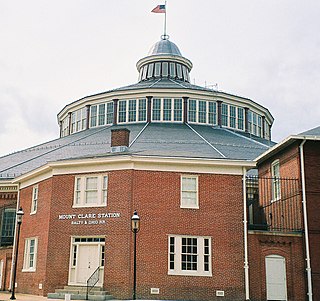
The B&O Railroad Museum is a museum and historic railway station exhibiting historic railroad equipment in Baltimore, Maryland. The Baltimore and Ohio Railroad (B&O) company originally opened the museum on July 4, 1953, with the name of the Baltimore & Ohio Transportation Museum. It has been called one of the most significant collections of railroad treasures in the world and has the largest collection of 19th-century locomotives in the U.S. The museum is located in the Baltimore and Ohio Railroad's old Mount Clare Station and adjacent roundhouse, and retains 40 acres of the B&O's sprawling Mount Clare Shops site, which is where, in 1829, the B&O began America's first railroad and is the oldest railroad manufacturing complex in the United States.

The ALCO S-2 and S-4 are 1,000-horsepower (746 kW) diesel electric switcher locomotives produced by ALCO and Canadian licensee Montreal Locomotive Works (MLW).
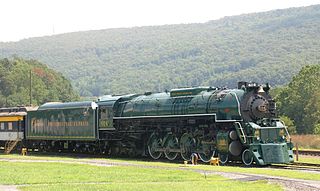
Chesapeake & Ohio 614 is a class "J-3-A" 4-8-4 "Greenbrier" (Northern) type steam locomotive built in June 1948 by the Lima Locomotive Works in Lima, Ohio for the Chesapeake and Ohio Railway (C&O) as a member of the J-3-A class. As one of the last commercially built steam locomotives in the United States, the locomotive was built with the primary purpose of hauling long, heavy, high speed express passenger trains for the Chesapeake & Ohio Railway such as the George Washington and the Fast Flying Virginian. Retired from active service in the late 1950s, the 614 was preserved and placed on display at the B&O Railroad Museum in Baltimore, Maryland. Between 1979 and 1980, restoration work on the locomotive to operating condition took place and it was used for extensive mainline excursion service from the early 1980s until the late 1990s. Since 2011, the locomotive has been on display at the C&O Railway Heritage Center in Clifton Forge, Virginia.

Reading 2101 is a preserved American class "T-1" 4-8-4 "Northern" type steam locomotive constructed in September 1945 for use by the Reading Company. Constructed from an earlier "I10SA" 2-8-0 "Consolidation"-type locomotive built in March 1923, the 2101 handled heavy coal train traffic for the Reading until being retired from revenue service in 1959. Withheld from scrapping, the 2101 served as emergency backup power for the three other T1 locomotives serving the Reading's "Iron Horse Rambles" excursions until being sold for scrap in 1964.
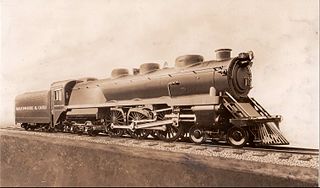
The Baltimore & Ohio Railroad's sole class V-2 4-6-4 steam locomotive, No. 2 Lord Baltimore, was constructed by the railroad's own Mount Clare Shops in 1935. It was built under the direction of the road's master mechanic George Emerson, and said to have been inspired by the Great Western Railway locomotive 6000 King George V which had appeared at B&O's 1927 Fair of the Iron Horse. The locomotive was constructed with an experimental water tube firebox, and operated at 350 psi when more typical operating pressure was 250 psi. The 84-inch drive wheels were the biggest ever on B&O steam. It was constructed to haul a new lightweight train, the Royal Blue, between New York City and Washington, DC. Later that year it was sent to the B&O-owned Chicago & Alton Railroad. It returned to the B&O in 1942 during World War 2 and, after work in B&O's shops, was renumbered to #5340 and assigned to service between Washington, DC and Cumberland, Maryland. Shortly afterward, it was withdrawn from service and stored at the railroad's shops in Baltimore, Maryland, and was scrapped in 1949.
On the Baltimore and Ohio Railroad, locomotives were always considered of great importance, and the railroad was involved in many experiments and innovations.

Oakland station is a historic railroad station located at Oakland, Garrett County, Maryland. It is a large brick structure with a two-story central section featuring a cylindrical tower with a domed cap and one-story wings extending from each end along the railroad tracks. It was designed by Baldwin and Pennington, and built in 1884 by the Baltimore and Ohio Railroad (B&O) across the tracks and a meadow from the Railroad's Oakland Hotel, which opened in 1876, to support the development of Oakland and Garrett County as a resort area. It is one of the finest remaining examples in Maryland of a Queen Anne style railroad station.

The Reading T-1 was a class of 4-8-4 "Northern" type steam locomotives owned by the Reading Company. They were rebuilt from thirty "I-10sa" class 2-8-0 "Consolidation" type locomotives between 1945 and 1947. Out of the thirty rebuilt, four survive in preservation today, those being numbers 2100, 2101, 2102, and 2124.
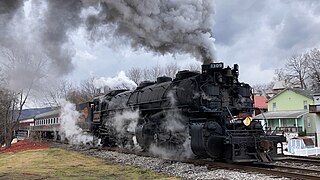
Western Maryland Scenic Railroad 1309 is a compound articulated class "H-6" "Mallet" type steam locomotive with a 2-6-6-2 wheel arrangement. It was the very last steam locomotive built by the Baldwin Locomotive Works in 1949 and originally operated by the Chesapeake and Ohio Railway (C&O) where it pulled coal trains until its retirement in 1956. In 1972, No. 1309 was moved to the B&O Railroad Museum for static display until 2014 when it was purchased by the Western Maryland Scenic Railroad (WMSR), who undertook a multi-year effort to restore it to operating condition. The restoration was completed on December 31, 2020, and the locomotive entered tourist excursion service for the WMSR on December 17, 2021. This was the first time an articulated locomotive operated in the Eastern United States since the retirement of Norfolk and Western 1218 in November 1991.

The Baltimore and Ohio’s P-7 class was a class of 20 Pacific type locomotives built in 1927. Named for the first 20 Presidents of the United States, they were the prime motive power for the B&O’s top passenger trains for 31 years. One example, Baltimore and Ohio 5300, the "President Washington", has been preserved.

Atlantic Coast Line 1504 is a 4-6-2 steam locomotive built in March 1919 by the American Locomotive Company (ALCO) of Richmond, Virginia, for the Atlantic Coast Line Railroad (ACL) as a member of the P-5-A class under the United States Railroad Administration (USRA) standard. No. 1504 was assigned to pull ACL's premier main line passenger trains during the 1920s to early 40s and even main line freight trains in the late 1940s until it was retired from revenue service at the end of 1952.

Baltimore and Ohio 4500 is a 2-8-2 "USRA Light Mikado" steam locomotive built by the Baldwin Locomotive Works in Philadelphia, Pennsylvania in July 1918 for the Baltimore and Ohio Railroad (B&O) as a member of the Q-3 class.
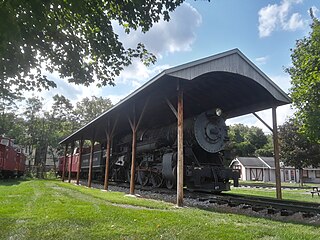
The Western Maryland K-2 was a class of 9 4-6-2 "Pacific" type steam locomotives built by the Baldwin Locomotive Works in 1912 and operated by the Western Maryland Railway until the early 1950s.

Spokane, Portland and Seattle Railway No. 539 is the only preserved example of the class O-3 2-8-2 "Mikado" steam locomotive. It was built by the American Locomotive Company in 1917 for the Northern Pacific Railway as engine No. 1762. It was sold to the Spokane, Portland and Seattle Railway and renumbered 539, in August 1944. It was reconfigured and converted to oil burning in January 1946. The locomotive was retired in 1957, and it was displayed in Esther Short Park, Washington, until 1997. That year, it was moved to Battle Ground for a potential restoration that never came to fruition. In 2007, it was acquired by the Grand Canyon Railway and moved to Williams, Arizona for an operational restoration that also never came to fruition. In 2019, No. 539 was purchased again by the Port of Kalama, who moved it back to Washington and put it on static display inside the Port's Interpretive Center that was constructed in 2014.
Atchison, Topeka and Santa Fe No. 1316 is a preserved 1309 class 4-6-2 "Pacific" type steam locomotive built by the Baldwin Locomotive Works in 1911 for the Atchison, Topeka and Santa Fe Railway. It was frequently used for pulling fast passenger trains in Texas, until it was reassigned to freight service in the late 1940s. After being retired in 1954, it was donated to the Fort Concho Museum in San Angelo, Texas for static display. In 1980, No. 1316 was acquired by the Texas State Railroad, who moved it to Rusk, Texas and restored it in 1982 as their No. 500. It continued to operate there until 2002, when it was found to be due for an overhaul, and it spent several years in storage, disassembled. As of 2024, No. 1316 has been put back together during a cosmetic restoration and it is awaiting the necessary overhaul required to operate it again.
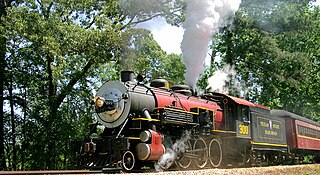
Southern Pine Lumber Company No. 28 is a preserved 2-8-0 “Consolidation” steam locomotive that was originally operated by the United States Army Transportation Corps. It is one of three survivors out of over 1,500 General Pershing locomotives built in 1917 for the War Department in World War I, originally numbered 396. After the war, the locomotive was sold off to the Claiborne and Polk Railroad for short distance freight service, and from there, it was sold multiple times throughout its revenue career, until 1956, when it was sold to the Southern Pine Lumber Company in East Texas, where it operated until it was retired in the early 1970s. In 1972, the locomotive was donated to the Texas Parks and Wildlife Department, who moved it to the Texas State Railroad for restoration four years later. After over twenty years of being stored, awaiting for restoration to come to fruition, the locomotive was fired up again in April 1996 as TSRR No. 300. It has pulled multiple excursion trains between Rusk and Palestine every year since its return to steam alongside a few other steam locomotives, including 2-8-2 No. 400. As of 2024, the locomotive was reverted to one of its original identities as SPLCO No. 28, but is currently getting its running gear repaired in Rusk.
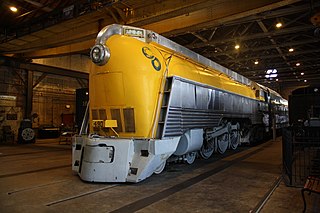
Chesapeake and Ohio No. 490 is the sole survivor of the L-1 class 4-6-4 "Hudson" type steam locomotives. It was built by Alco's Richmond works in 1926 as an F-19 class 4-6-2 "Pacific" type to be used to pull the Chesapeake and Ohio's secondary passenger trains. It was eventually rebuilt in 1947 to become a streamlined 4-6-4 for the C&O's Chessie streamliner. After the Chessie was cancelled, No. 490 remained in secondary passenger service, until it was retired in 1953. It spent several years in storage in Huntington, West Virginia, until 1968, when it was donated to the B&O Railroad Museum in Baltimore, Maryland. It remains on static display at the museum, as of 2023.

Grand Trunk Western No. 6323 is a preserved class "U-3-b" 4-8-4 "Northern" type steam locomotive built by Alco in 1942. It served the Grand Trunk Western Railroad by pulling various heavy freight and passenger trains across the Lower Peninsula of Michigan and Northern Indiana. It became famous in later years for being the very last active steam locomotive to run on the GTW's trackage while still on the railroad's active list in 1961. After sitting in storage for several years in Detroit, No. 6323 was sold in 1981 to the Illinois Railway Museum, and since then, it has remained on static display in Union, Illinois.

















